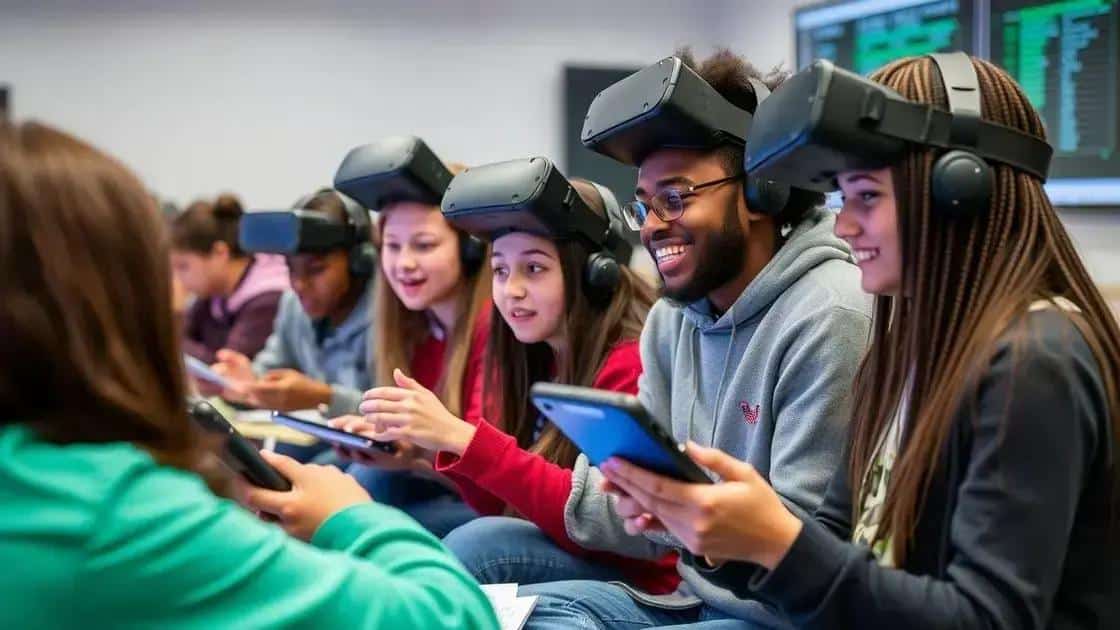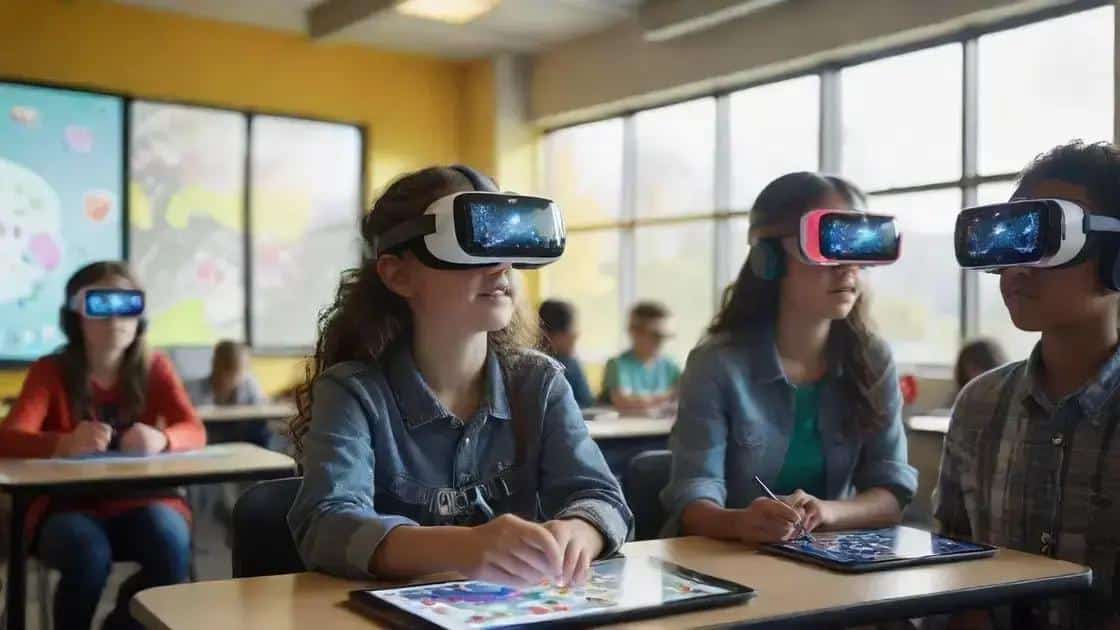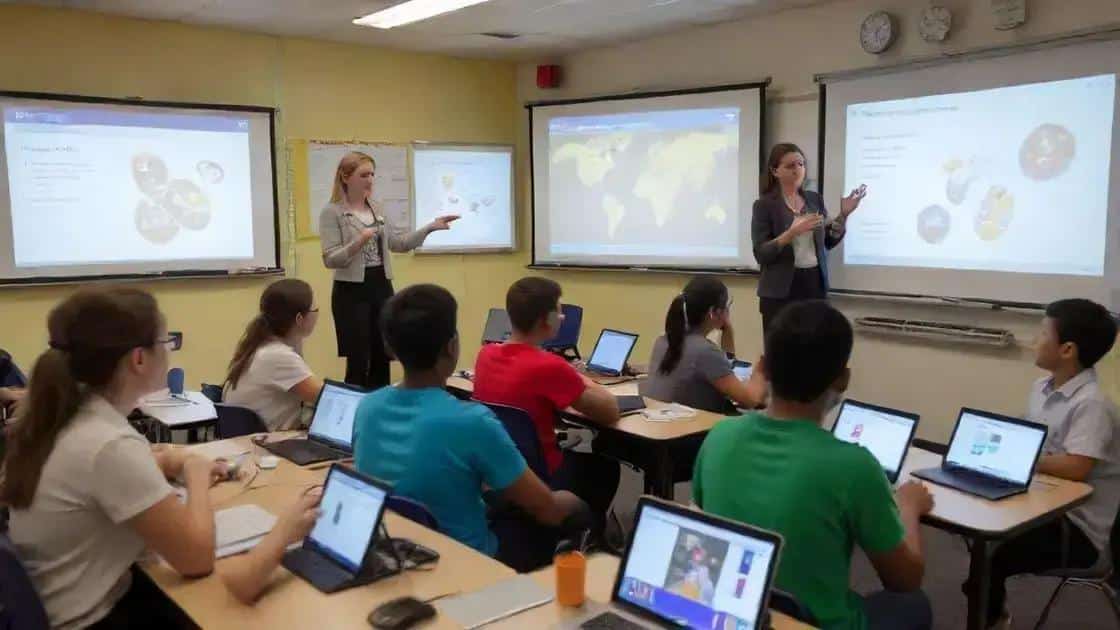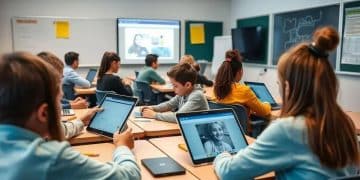Gamified learning platforms trends you should know

Gamified learning platforms enhance student engagement and motivation by incorporating game elements like rewards and challenges, while addressing implementation challenges such as technology integration and educator training.
Gamified learning platforms trends are transforming how we approach education and skills development. Have you ever wondered how game mechanics could enhance learning experiences? This article dives into these trends and explores their potential.
Understanding gamified learning concepts
Understanding gamified learning concepts is essential for educators and organizations looking to enhance learning experiences. This approach uses game elements to motivate and engage learners. Imagine turning a mundane task into an exciting game; that’s the power of gamified learning.
At its core, gamified learning involves integrating game mechanics into educational environments. This could mean introducing points, badges, or challenges to make learning more immersive. Such techniques can significantly impact how students perceive their educational journey, making it more enjoyable.
Key Elements of Gamified Learning
Several essential components drive the effectiveness of gamified learning platforms:
- Feedback: Instant feedback keeps learners informed about their progress.
- Rewards: Badges and certificates encourage users to achieve their goals.
- Competition: Leaderboards can spark friendly competition, increasing engagement.
- Storytelling: A compelling narrative can captivate learners, making the experience more relatable.
Incorporating these elements fosters a motivating learning environment. Learners often feel a sense of accomplishment with clear, achievable goals. They become more active participants in their education.
As we explore gamified learning further, it’s crucial to understand the psychology behind these concepts. Motivation is a key driver in education. When learners see progress and receive rewards, they are more likely to persist in their studies. This technique promotes a growth mindset, empowering students to embrace challenges.
The Impact of Games on Learning
Research shows that games can boost memory retention and increase engagement. By tapping into the emotional and social aspects of gaming, educators can bridge the gap between traditional learning methods and modern expectations.
A recent study indicated that students exposed to gamified elements improved their retention rates by 40%. It highlights how integrating fun into learning can lead to substantial outcomes and promote lifelong learning behavior.
Key trends in gamified learning platforms

Key trends in gamified learning platforms are shaping the future of education. As technology evolves, so do the methods of engagement in learning environments. Educators are increasingly focusing on incorporating these trends to enhance student motivation and participation.
One significant trend is the use of adaptive learning technologies. These systems customize learning experiences based on individual student responses. This personal touch keeps learners engaged and helps them master concepts at their own pace. Adaptive technologies also provide instant feedback, making learning more efficient.
Mobile Gamification
Another trend gaining momentum is the rise of mobile gamification. With the prevalence of smartphones and tablets, educational games are easily accessible. This accessibility allows students to learn from anywhere, turning downtime into productive learning sessions.
- Flexibility: Learners can engage with educational materials at their own convenience.
- Increased Engagement: Mobile games attract students through appealing visuals and interactive components.
- Social Learning: Many mobile platforms encourage collaboration among peers.
In addition, the integration of virtual and augmented reality (VR/AR) is revolutionizing gamified learning. These immersive technologies create realistic environments for learners. For instance, medical students can practice surgeries in a virtual setting, making the learning experience not only interactive but also practical.
Furthermore, the use of data analytics is becoming more prevalent in gamified platforms. Educators can track student performance and engagement more effectively. This data-driven approach allows for smarter decisions about content and teaching strategies, ultimately leading to improved student outcomes.
Community-Building
Community features also play a vital role in gamified learning. As learners engage with one another, they build a supportive environment. Many platforms now include forums and social sharing options, encouraging collaboration and competition.
The blend of competition and collaboration fosters a sense of belonging. When students interact, they can share challenges and strategies, enhancing their overall learning journey.
Benefits of gamified learning for engagement
Benefits of gamified learning for engagement are significant and varied. When implemented effectively, gamified learning can transform traditional education methods into interactive experiences that captivate learners. This approach not only makes learning more enjoyable but also enhances retention and understanding.
One of the main advantages is that gamified learning increases motivation. By integrating game elements like points, levels, and badges, learners feel a sense of achievement as they progress. This positive reinforcement encourages them to participate actively, fostering a deeper connection to the material.
Enhanced Learning Outcomes
Another benefit is improved learning outcomes. Gamification promotes critical thinking and problem-solving skills. As students face challenges and puzzles within an educational game, they develop their ability to analyze situations and make decisions. This practical application of skills prepares them for real-world scenarios.
- Retention: Engaging elements help students remember information longer.
- Collaboration: Many games encourage teamwork, enhancing social skills.
- Creativity: Learners can express themselves by taking creative approaches within the game environment.
Moreover, gamified learning environments often lead to increased participation. Students who might be hesitant in traditional settings may find the game aspect more inviting. They are more likely to share ideas, work with peers, and participate in discussions, creating a vibrant learning community.
Additionally, gamification can cater to different learning styles. Visual learners might thrive in environments rich with graphics, while kinesthetic learners can interact through hands-on activities. This flexibility allows for a more inclusive approach that meets the diverse needs of all students.
Long-Term Engagement
Another crucial benefit is the potential for long-term engagement. When learners find joy in their education, they are likely to pursue knowledge beyond the classroom. This intrinsic motivation can lead to a lifelong love of learning.
By creating a fun and supportive context for learning, educators can ignite curiosity and encourage exploration. Ultimately, gamified learning not only boosts engagement but also prepares students for a successful future.
Challenges in implementing gamified learning

Challenges in implementing gamified learning are important considerations for educators and organizations. While gamification can significantly enhance learning experiences, several hurdles can arise during its implementation. Recognizing these challenges helps create effective strategies to overcome them.
One major challenge is technology integration. Many educational institutions still rely on outdated systems that may not support modern gamified tools. This can lead to frustrations for both educators and students. To address this, it is crucial to invest in updated technologies that can provide a seamless experience.
Training Educators
Another significant challenge is training educators to use gamified platforms effectively. Not all teachers are familiar with game-based learning or its benefits. Providing professional development opportunities is essential for ensuring that teachers feel confident in implementing these methods.
- Understanding Game Mechanics: Educators must learn how to apply game mechanics in a way that enhances learning.
- Designing Content: Crafting engaging and effective game-based content requires special skills.
- Ongoing Support: Continuous support may be necessary as teachers experiment with new techniques.
Some students may also face challenges adapting to a gamified learning environment. Students who are used to traditional methods may struggle to engage with new approaches. Providing clear instructions and support can ease this transition, helping students to embrace the gamified experience.
Furthermore, achieving motivation balance can be tricky. While gamification aims to increase motivation through rewards, excessive focus on these rewards can diminish intrinsic motivation. It’s important to strike the right balance to ensure that learners are genuinely engaged with the content, rather than just aiming for points or badges.
Assessing Learning Outcomes
Measuring the effectiveness of gamified learning can also present challenges. Traditional assessment methods may not capture the full scope of learning that occurs through gamification. Educators need to develop new metrics and assessment techniques that truly reflect student progress in a gamified context.
Ultimately, while implementing gamified learning comes with challenges, addressing these issues can lead to successful outcomes. Overcoming technological barriers, training educators effectively, supporting students, balancing motivations, and adapting assessment methods are crucial steps in harnessing the power of gamified learning.
FAQ – Frequently Asked Questions about Gamified Learning
What are the main benefits of gamified learning?
Gamified learning enhances engagement, motivation, and collaboration among students, leading to an improved educational experience.
What challenges might schools face when implementing gamified learning?
Schools may struggle with technology integration, training educators, and ensuring that all students adapt to new learning methods.
How does gamification affect student motivation?
Gamification uses rewards and achievements to boost student motivation, encouraging active participation in their learning journey.
Can gamified learning cater to different learning styles?
Yes, gamified learning can accommodate various learning styles by incorporating visual, auditory, and kinesthetic elements.





